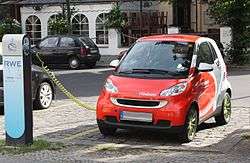Electric bus
An electric bus is a bus that is powered by electricity.

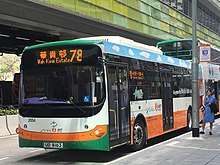

Electric buses can store the electricity on board, or can be fed continuously from an external source. Buses storing electricity are majorly battery electric buses, in which the electric motor obtains energy from an on-board battery, although examples of other storage modes do exist, such as the gyrobus which uses flywheel energy storage. When electricity is not stored on board, it is supplied by contact with outside power sources. For example, overhead wires, as in the trolleybus, or with non-contact conductors on the ground, as in online electric vehicles.[1] This article mostly deals with buses storing the electricity on board.
As of 2019, 99% of the battery electric buses in the world have been deployed in China, with more than 421,000 buses on the road, which is 17% of China's total bus fleet.[2] For comparison, the US had 300, and Europe had 2,250.[3]
History
Electric vehicles have been around since the 19th century. In the early 19th century, researchers in Hungary, the Netherlands, and the United States began exploring the idea of battery-powered vehicles. There had previously been progress with an electric carriage, a horseless carriage that was powered by an electric motor. However, as people wanted to get around more easily and quickly, cars became a faster and more reasonable alternative to horse-drawn carriages.
In 1835, American Thomas Davenport is credited with building the first practical electric vehicle, a small locomotive. He developed a battery-powered electric motor which he used to operate a small model car on a short section of track.
The first successful electric car was made in the United States in 1890. William Morrison of Des Moines, Iowa, built an electric vehicle that could hold up to six passengers and could reach from 6 to 12 miles per hour.[4] Specifications for the 1890 Morrison Electric included 24 storage battery cells mounted under the front seat. The vehicle could travel for a range of 100 miles before needing to be recharged.
This initial invention helped spark interest in electric cars, and automakers started building their own versions around the globe. Due to the extreme sudden interest, electric cars reached their peak popularity by 1900 and made up a majority of all vehicles on the road.
At this time electric cars were the preferred vehicles. Gasoline-powered vehicles required a lot of effort to drive, from changing gears to starting the engine with a hand crank, as well as other cons like strong and unpleasant exhaust fumes.
However, improvements were made to the gasoline-powered car that caused the electric car to lose some momentum. The hand crank was soon replaced with an electric starter and gasoline-powered vehicles became more affordable. Gasoline cars soon overcame the popularity of electric powered vehicles.
By 1935, electric cars practically disappeared. It was not until the 1970s when a gas shortage hit, causing gas prices to soar, that electric cars entered back into the marketplace. Gasoline-powered cars still remained more popular due to better performance and reliability.
The 1990s saw electric cars made more popular as societal concern for the environment began to rise. At the start of the 21st century, the technology of electric cars looked more promising than ever with the release of the Toyota Prius, the first majorly manufactured electric vehicle. Today, electric vehicles are on the rise and continue to advance as more Americans demand a more efficient and eco-friendly vehicle.[5]
Principles
Battery
One of the most popular types of electric buses nowadays are battery electric buses. Battery electric buses have the electricity stored on board the vehicle in a battery. As of 2018 such buses can have a range of over 280 km with just one charge, however extreme temperatures and hills may reduce range.[6] These buses are usually used as city buses due to particularities in limited range.
City driving involves a great deal of accelerating and braking. Due to this, the battery electric bus is superior to diesel bus as it can recharge most of the kinetic energy back into batteries in braking situations. This reduces brake wear on the buses and the use of electric over diesel reduces noise, air and greenhouse gas pollution in cities.[7]
When operating within a city, it is important to minimize the unloaded and rolling weight of the bus. This can be accomplished by using aluminium as the main construction material for a bus. Composite paneling and other lightweight materials can also be used. According to Linkkebus their fully aluminium bus construction is about 3000 kg lighter than comparably-sized modern steel buses (curb weight 9500 kg). Reducing weight allows for a greater payload and reduces wear to components such as brakes, tires, and joints bringing cost savings to the operator annually.[8]
Capacitors
Buses can use capacitors instead of batteries to store their energy. Ultracapacitors can only store about 5 percent of the energy that lithium-ion batteries hold for the same weight, limiting them to a couple of miles per charge. However ultracapacitors can charge and discharge much more rapidly than conventional batteries. In vehicles that have to stop frequently and predictably as part of normal operation, energy storage based exclusively on ultracapacitors can be a solution.[10]
China is experimenting with a new form of electric bus, known as Capabus, which runs without continuous overhead lines by using power stored in large on-board electric double-layer capacitors, which are quickly recharged whenever the vehicle stops at any bus stop (under so-called electric umbrellas), and fully charged in the terminus.
A few prototypes were being tested in Shanghai in early 2005. In 2006, two commercial bus routes began to use electric double-layer capacitor buses; one of them is route 11 in Shanghai.[11] In 2009, Sinautec Automobile Technologies,[12] based in Arlington, VA, and its Chinese partner, Shanghai Aowei Technology Development Company[13] are testing with 17 forty-one seat Ultracap Buses serving the Greater Shanghai area since 2006 without any major technical problems.[14] Another 60 buses will be delivered early next year with ultracapacitors that supply 10 watt-hours per kilogram.
The buses have very predictable routes and need to stop regularly, every 3 miles (4.8 km), allowing opportunities for quick recharging. The trick is to turn some bus stops along the route into charging stations. At these stations, a collector on the top of the bus rises a few feet and touches an overhead charging line. Within a couple of minutes, the ultracapacitor banks stored under the bus seats are fully charged. The buses can also capture energy from braking, and the company says that recharging stations can be equipped with solar panels. A third generation of the product, will give 20 miles (32 km) of range per charge or better. [10] Such a bus was delivered in Sofia, Bulgaria in May 2014 for 9 months' test. It covers 23 km in 2 charges.[15]
Sinautec estimates that one of its buses has one-tenth the energy cost of a diesel bus and can achieve lifetime fuel savings of $200,000. Also, the buses use 40 percent less electricity compared to an electric trolley bus, mainly because they are lighter and have the regenerative braking benefits. The ultracapacitors are made of activated carbon, and have an energy density of six watt-hours per kilogram (for comparison, a high-performance lithium-ion battery can achieve 200 watt-hours per kilogram), but the ultracapacitor bus is also cheaper than lithium-ion battery buses, about 40 percent less expensive, with a far superior reliability rating.[10][14]
There is also a plug-in hybrid version, which also uses ultracaps.
Future developments
Sinautec is in discussions with MIT's Schindall about developing ultracapacitors of higher energy density using vertically aligned carbon nanotube structures that give the devices more surface area for holding a charge. So far, they are able to get twice the energy density of an existing ultracapacitor, but they are trying to get about five times. This would create an ultracapacitor with one-quarter of the energy density of a lithium-ion battery.[16]
Future developments includes the use of inductive charging under the street, to avoid overhead wiring. A pad under each bus stop and at each stop light along the way would be used.
Drawbacks
As with other electric vehicles, climate control and extremely cold weather will weaken the performance of electric buses. In addition, terrain may pose a challenge to the adoption of electric vehicles that carry stored energy compared to trolleybuses, which draw power from overhead lines. Even when conditions are favorable, internal combustion engine buses are frequently diesel powered, and diesel is relatively inexpensive per mile. High local utility rates (especially during periods of peak demand) and proprietary charging systems pose barriers to adoption.[17]
Makers and models
School use
In 2014, the first production-model all-electric school bus was delivered[18] to the Kings Canyon Unified School District in California's San Joaquin Valley. The Class-A school bus was built by Trans Tech Bus, using an electric powertrain control system developed by Motiv Power Systems, of Foster City, California. The bus was one of four the district ordered. The first round of SST-e buses (as they are called) is partly funded by the AB 118 Air Quality Improvement Program administered by the California Air Resources Board.
The Trans Tech/Motiv vehicle has passed all KCUSD and California Highway Patrol inspections and certifications. Although some diesel hybrids are in use, this is the first modern electric school bus approved for student transportation by any state.
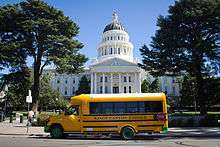
Since 2015, the Canadian manufacturer Lion Bus offers a full size school bus, eLion, with a body made out of composites. It is a regular production version that is built and shipped in volume since early 2016, with around 50 units sold until 2017.[19]
Transit use
- For information on where trolleybuses are in use, see Trolleybus usage by country and List of trolleybus systems.
Transit authorities that use battery buses or other types of all-electric buses, other than trolleybuses:
Asia
Malaysia
- Bandar Sunway
- Putrajaya[20][21]
- Melaka City[22]
- Selangor[23]
- Kota Kinabalu (coming soon 2018)[24]
- Kota Bharu (coming soon 2018)[25]
- Kuching (on trial since 1 March 2019)[26]
Indonesia
- TransJakarta plans to replace aging fleet with newer electric powered buses. Available candidates are locally made MAB buses and imported BYD buses. Technical trials started by September 2019.[27]
- Paiton Energy took delivery of the first locally produced electric bus made by PT MAB.[28]
India
- India's first electric bus was launched in Bengaluru in 2014.[29]
- The first inter-city bus service, from Mumbai to Pune, was launched in 2019.[30]
- In October 2016, Ashok Leyland, launched the first 100% India-made electric bus. The series have been named Circuit and it can carry 35 to 65 persons at a time.
- Pune Mahanagar Parivahan Mahamandal (PMPML) have employed electric buses supplied by BYD and its Indian partner Olectra Greentech.
- Himachal Road Transport Corporation have started to employ Goldstone-BYD (Model K7e Buzz - 9 meters) in local routes in Himachal Pradesh[31]
- BEST (Brihanmumbai Electric Supply and Transport) have started to employ Goldstone-BYD buses on few selected routes in Mumbai[32]
- Telangana State Road Transport Corporation (TSRTC) have started to ply Goldstone-BYD buses in Hyderabad and Secunderabad[33]
- Navi Mumbai Municipal Transport (NMMT) have started to ply JBM suppplied JBM Solaris buses on local routes.[34]
- Ahmedabad Janmarg Ltd. have employed buses manufactured by Ashok Leyland in BRTS[35]
China

As of 2016, 156,000 buses are being put into service per year in China.[36]
- Beijing
- Bengbu[37]
- Changsha (BYD x 180 vehicles)[38]
- Haikou (BYD)[39]
- Lhasa, First solar powered public bus in 2015 [40]
- Shanghai (capabuses).
- Shaoguan (BYD)[41]
- Shenzhen (BYD x 16,359 vehicles). As of 1 January 2018, every bus in Shenzhen is battery-electric.[42]
- Tianjin (BYD)[43]
- Xi'an (BYD)[44]
- Yancheng.[45]
- Bengbu (BYD x 638 vehicles)[46]
Japan

- Community Bus "Hamurun" (Operated by Nishi Tokyo Bus) in Hamura, Tokyo since 10 March 2012[47]
- Community Bus "Sumida Hyakkei" (Operated by Keisei Bus) in Sumida, Tokyo since 20 March 2012[48]
- Kitakyushu City, Japan.[49]
South Korea
- Seoul has 15 electric buses nicknamed "Peanut Bus" for their shape, transferring people from subway stations in downtown to the N Seoul Tower, circulating Mt. Namsan.[50]
- Seoul's Gangnam District will have 11 electric buses in operation from February 2013 and 270 electric buses by the end of 2013, increasing to 400 buses by 2014.[51] At least 3,500 electric buses will be introduced in phases until 2020, which will account for half of Seoul's bus fleet.[52]
- Gumi will have the world's first wireless electric bus, known as Online Electric Vehicle, in operation from July 2013 developed by KAIST. Electricity is wirelessly fed into the bus from the tracks.[1][53]
- Pohang will have automatically battery switching electric buses in operation from July 2013. Unlike conventional plug-in charging buses, the battery pack is automatically swapped with a fully charged one before complete drainage.[54]
Europe
Belarus
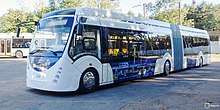
- Е433 «Vitovt Max Electro» (Minsk)[55]
- E420
- E321
Turkey
Finland
- Espoo Cobus EL2500 (bus 11 Friisilä-Tapiola Centre)
- Espoo (Linkker 2 vehicles, Bus 11 line Tapiola centre-Friisilä)[56]
Great Britain
- 51 electric buses for the 507 and 521 bus routes in London, delivered jointly by BYD and ADL.[58]
- Stagecoach North Scotland operates 5 Optare solo EV [59]
- Strathclyde Partnership for Transport runs battery-powered electric buses on one route in Glasgow, between George Square and the Transport Museum.[60]
- Bristol: Route 72 from City Centre to Frenchay UWE campus[61]
- Durham: Cathedral and City Centre loop[62][63]
- Milton Keynes: Route 7[64]
- Greater Manchester: Stagecoach plans to buy 105 electric buses for use in the Greater Manchester area by 2020.[65]
- Guildford introduced a fleet of electric buses on its Park and Ride services on 7 January 2019.[66]
Italy
- Azienda Trasporti Bergamo — Bergamo, Italy [67]
- Gruppo Torinese Trasporti — Turin, Italy, uses small capacitor vehicles on two routes ("Star1" and "Star2") through city center since early 2000.
- Azienda Trasporti Milanesi, the company responsible for public transportation in Milan, has ordered 250 electric buses in 2019, and plans to be fully electrified by 2030. As of 2019, there are 25 electric buses, 100 hybrid buses and 3 hydrogen buses in operation in the city.[68]
Lithuania
- Municipal public transport company "Klaipėdos autobusų parkas", Klaipėda, started using locally produced Dancer electric buses on Route 8 in April 2020.[69]
- Municipal public transport company "Kauno autobusai", Kaunas, operates electric trolleybuses since 1965. As of April 2020, the company operated around 100 Solaris Trollino 12AC and several Berkhof Premier AT18 trolleybuses on a network of 17 lines.
- Municipal public transport company "Tauragės autobusų parkas", Tauragė in March 2019 announced the acquisition of electric Iveco Rosero 70C18 and Solaris Urbino Electric buses. A total of 5 electric buses were launched on three suburban routes in early 2020.
- Municipal public transport company "Susisiekimo paslaugos", Vilnius, stated using four Karsan Jest Electric buses on Route 89 in September 2019, making this route fully electric. This is an addition to the network of 19 routes, operated with 279 electric trolleybuses, mostly Solaris Trollino 15AC, Solaris Trollino IV 12, Škoda 14Tr, Škoda 14ТrМ, Škoda 15Тr and Amber Vilnis 12 AC, as of April 2020. Vilnius trolleybus network was launched in 1956.
Netherlands

- 43 fully electric VDL 18 meter buses are deployed in Eindhoven, driving a daily distance of 400 km each. The Eindhoven operation is currently the biggest all-electric bus operation of Europe (2017). At the end of 2017, VDL will have a fleet of over 200 fully electric vehicles driving in the Netherlands and Germany, with over 5,000,000 km done and no technical breakdowns.
- 6 all-electric BYD buses in April 2013 on the island of Schiermonnikoog. Right now, there are many electric buses driving in the Netherlands. Starting 11 December 2016, with the new bus schedule for 2017, Hermes started running 43 buses to the bus transport of Eindhoven. Arriva started running 16 electric buses on Vlieland, Ameland and Schiermonnikoog, and several more in Limburg. Utrecht already had electric buses on route 2, and trolley buses have been operating for decades in the city of Arnhem.
Poland
- Kraków (Cracow): In January 2016, first 2 Solaris Urbino 12 electric buses were delivered by Solaris Bus & Coach. In September 2016, further 4 Solaris Urbino 8,9 LE electric buses were delivered by the same manufacturer. A roadside charger was installed at a bus stop on Pawia street.
- Warszawa (Warsaw): In June 2015, Solaris Bus & Coach delivered 10 Solaris Urbino 12 electric buses. They are running on route 222. A further 20 electric buses are on order, first 10, manufactured by Ursus Bus, due to be delivered in summer of 2017 and further 10 Solaris Urbino 12 electrics by end of March 2018. There are also plans to purchase further 130 electric buses by 2020. 19 termini will be equipped with chargers, allowing buses to be topped-up using roof-mounted pantographs.[70][71][72]
- Zielona Góra: In October 2017 MZK Zielona Góra order 47 electric buses Ursus City Smile 12E manufactured by Ursus Bus.[73]
- Stalowa Wola: In September 2017 ZMKS Stalowa Wola order 10 electric buses Solaris Urbino 8,9 LE electric manufactured by Solaris Bus & Coach.[74]
Romania
- Cluj-Napoca: In May 2018, Solaris Bus & Coach delivered 11 Solaris Urbino 12 electric buses to the local operator CTP Cluj, Cluj-Napoca becoming the first city in Romania to use battery-electric buses in public transport. (Electric buses in the form of trolleybuses were already in use in Cluj and several other Romanian cities.) Another 19 buses are expected to be delivered in the future. The municipality's mayor, Emil Boc, announced that Cluj will have a fully electric public transport system by 2025.[75]
Russia
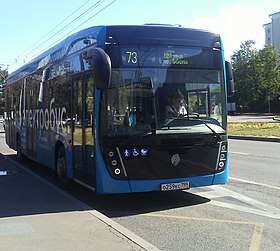
- In 2014 battery-powered trolleybuses started operating in Chelyabinsk. The remodeled vehicles can run up to 30 km on routes that lack wires.[76]
- In 2018 electric buses were introduced in Moscow. The city government has signed contracts with GAZ and Kamaz automobile companies to supply the city with 200 fast-charging electric buses. After 2021, only electric vehicles are to be purchased.[77] With the purchase of 100th electric bus in May 2019, Moscow became the city with Europe's largest electric bus fleet. As of July 2020, over 400 electric buses are in operation in Moscow.
Serbia
- In 2016 GSP Belgrade, the public transport operator of city of Belgrade, launched dedicated electric bus line equipped exclusively with 5 electric buses.[78] The line has a total length of 7.9 kilometres one-way and 13 bus stops.
Spain
Sweden
Switzerland
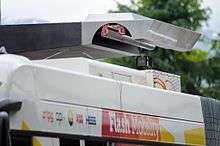
North America
Canada
British Columbia
- Vancouver electric buses have been in operation since 1948, TransLink operates 260 of them.
- Victoria - CVS Tours currently deploys North America's first all-electric double decker bus made by GreenPower Motor Company.[88]
Québec
- Réseau de transport de la Capitale, Quebec City's public transit authority has integrated 8 electric buses to its fleet in 2008 to serve the Old City.[90] The Tecnobus Gulliver buses can carry up to 20 passengers and runs on $3.25 worth of electricity per day.[91]
- Société de transport de Montréal, Montreal, bus fleet going all-electric or hybrid by 2029.[92] 2017 - Cité-Mobilité project : 3 electric bus on line 36 with high-speed charging.[93]
United States
About 650 electric buses were on the road in the US in 2019, about double the 300 estimated to be in use the previous year.[94] In November 2019, orders for new electric buses had outpaced manufacturing capacity.[94]
Cities using electric buses include:
- Anaheim, CA
- Atlanta, GA (at Emory University)
- Cambridge, MA (with the 71, 72, 73, and some 77 busses to and from Harvard Square)
- Chattanooga, TN - CARTA Downtown Electric Shuttle[95]
- Colorado Springs, CO
- Dallas, TX[96]
- Dayton, OH
- Denver, CO - RDT Free MallRide[97]
- Frederick, MD
- Greenville, SC
- Gulfport, MS, with Mississippi's first electric bus in 2019 [94]
- Hampton, VA
- Lexington, KY
- Los Angeles, CA
- Louisville, KY
- Miami Beach, FL
- Mobile, AL
- Nashville, TN
- New Haven, CT
- Pomona, CA
- Portland, ME, received funding for Maine's first electric buses, operational 2021 [94]
- Portland, OR
- Philadelphia, PA
- Providence, Rhode Island The Rhode Island Public Transit Authority RIPTA is currently testing 3 electric buses on various routes around Providence.
- Reno, NV
- Santa Barbara, CA
- San Antonio, TX
- San Diego, CA[98]
- San Francisco, CA, where electric trolleybuses are already commonplace on most SF Muni routes.
- Seattle, WA, which has a trolleybus network of its own.
- Seneca, SC
- Stockton, CA
- Tallahassee, FL
- Worcester, MA
- Wichita, KS
California
A California mandate (Zero Emission Bus, in short, ZBus) required that 15% of new buses after 2011 be electric.[99] The ZBus Regulation is part of the Fleet Rule for Transit Agencies, which is also referred to as the Public Transit Agencies Regulation.[100][101]
Long Beach, California and the Antelope Valley Transit Authority charge some of their buses on special wireless charging pads located along bus routes.[9]
By 2019, more than 200 e-buses were in service in California. Several hundred more e-buses for California were in backlogged orders.[94]
States without plans for e-buses
In 2019, "only five states, Arkansas, New Hampshire, North Dakota, South Dakota and West Virginia, ... [had] no transit agencies planning to operate electric buses or hydrogen fuel cell buses."[94]
Oceania
Australia
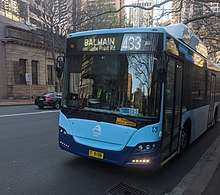
- In September 2017, Transport Canberra began operating two electric buses based at their Tuggeranong depot.[102]
- Transport for New South Wales began a trial of electric buses on the South Coast before conducting a more expansive trial in region 4 in Sydney in 2019.
- Melbourne's first fully electric bus began carrying passengers on Route 246 between Elsternwick and Clifton Hill in October 2019. The body construction and fit out for the new bus was carried out in Dandenong by Volgren.[103]
New Zealand
- In April 2018, Auckland Transport began a trial with two electric Alexander Dennis Enviro200 buses.[104] These buses run on the City Link service around Auckland's central business district. The trial continues as of February 2019.
- In July 2018, Tranzurban introduced 10 electric double Decker buses in Wellington. 22 more buses are expected to be in service by 2021. NZ Bus have ordered 67 single Decker buses which will enter service between 2021 and 2023.
- In June 2019, Red Bus introduced three Alexander Dennis Enviro200 bodied BYD K9 electric buses for use on the 29 Airport route.[105][106]
South America
Aruba
- Oranjestad (BYD)[107]
Brazil
- Sao Paulo (BYD)[108]
 2 BYD Buses in Nanjing China
2 BYD Buses in Nanjing China
Chile
- Santiago (BYD)[109]
- Valparaiso (BYD)[109]
Uruguay
- Montevideo (BYD x 200 vehicles)[111]
See also
References
- "OLEV". Archived from the original on 31 December 2013.
- "Electric Buses Are Hurting the Oil Industry". 23 April 2018 – via www.bloomberg.com.
- Bloomberg - Are you a robot?
- "The Morrison Electric Automobile & The William Morrison Co". american-automobiles.com. Retrieved 9 October 2017.
- "Are Electric Buses the Future of Transportation? - GOGO Charters". 16 August 2017.
- "The Verdict's Still Out on Battery-Electric Buses". Citylab. 17 January 2019.
- "Shenzhen's silent revolution: world's first fully electric bus fleet quietens Chinese megacity". The Guardian. 12 December 2018.
- "Archived copy". Archived from the original on 4 March 2016. Retrieved 25 May 2016.CS1 maint: archived copy as title (link)
- Kennedy, Sarah (5 December 2019). "Electric buses charge up quickly using new wireless systems". Yale Climate Connections. Retrieved 8 December 2019.
- "Next Stop: Ultracapacitor Buses". Technology Review. Retrieved 28 July 2010.
- (in Chinese, archived page)
- "SINAUTEC, Automobile Technology, LLC". Sinautecus.com. Retrieved 28 July 2010.
- "Aowei Technology". Aowei.com. Archived from the original on 25 January 2010. Retrieved 28 July 2010.
- "Ultracapacitor Buses Work... As Long as You have Lots of Quick-Charge Stations". TreeHugger. Retrieved 28 July 2010.
- "Sofia – Chariot Motors". chariot-electricbus.com.
- "Next Stop: Ultracapacitor Buses". Technology Review. Retrieved 28 July 2010.
- Groom, Nichola (11 December 2017). "U.S. transit agencies cautious on electric buses despite bold forecasts". Reuters. Retrieved 7 August 2018.
- Dechert, Sandy (5 March 2014). "New All-Electric School Bus Saves California District $10,000+ Per Year". cleantechnica.com. Retrieved 20 August 2018.
- "Archived copy". Archived from the original on 30 January 2017. Retrieved 25 February 2016.CS1 maint: archived copy as title (link)
- "取代柴油巴士打造零碳环境.8电动巴士布城开跑". 29 August 2017.
- "东姑安南:明年中运作·5电动巴士川行布城". 11 December 2017.
- "世遗区开动.甲电动巴士8月开跑". 3 July 2015.
- "精明巴士2年花4253万.邓章钦:考量需求才推新路线". 4 October 2017.
- "全国首座城市 环保电动车 进驻亚庇". 11 November 2017.
- "川行哥市市区.丹电动巴士来了!". 2 November 2017.
- "Electric bus debuts on Friday, passengers ride for free for 3 months". The Borneo Post. 26 February 2019.
- Donny Dwisatryo Priyantoro (8 September 2019). Azwar Ferdian (ed.). "TransJakarta Uji Coba Bus Listrik dengan Angkut Galon Air, Ini Rutenya". otomotif.kompas.com (in Indonesian). Retrieved 26 May 2020.
- "Produksi Perdana Bus Listrik MAB Diserahkan ke Paiton Energy". otomotif.tempo.co (in Indonesian). 2 November 2019. Retrieved 26 May 2020.
- "India's first electric bus launched in Bangalore - The Times of India". The Times Of India.
- Sep 6, Somit Sen | TNN | Updated. "Maharashtra: Inter-city AC electric bus to hit state highways, first for nation | Mumbai News - Times of India". The Times of India. Retrieved 25 September 2019.
- "Electric Buses". india.uitp.org. 23 March 2020.
- "Best Mumbai Inducted Fleet Of Electric Buses". india.uitp.org.
- "Public Transport In Telangana Goes Electric As 40 Electric Buses Hit Hyderabad Roads | News". NDTV-Dettol Banega Swasth Swachh India. 6 March 2019. Retrieved 23 March 2020.
- Staff, Local Press Co (27 August 2019). "NMMT takes delivery of first electric bus, 30 such buses to start plying in Navi Mumbai soon". Local Press Co. Retrieved 23 March 2020.
- "Deployment of Electric Buses by Janmarg: Opportunities and Challenges" (PDF).
- "China Electric Bus Sales Still Exploding". CleanTechnica. 25 February 2017.
- "市公共交通集团有限公司比亚迪牌纯电动成交公示—蚌埠市政府信息公开网". zwgk.bengbu.gov.cn. Archived from the original on 31 July 2017. Retrieved 16 June 2017.
- "Chinese carmaker BYD's Changsha facility becomes the country's leading new energy vehicle base". AMTonline. 28 September 2012. Retrieved 2012-10-26.
- "比亚迪k9纯电动大巴海口运行状况良好_中国电动汽车网站资讯频道" (in Chinese). Ddc.net.cn. 11 October 2011. Retrieved 2012-10-26.
- "First solar powered public bus operates in Tibet". China Daily. 24 November 2015. Retrieved 1 January 2020.
- First Thailand Orders for Long-range BYD e6 EV". Global Renewable News. 10 September 2012. Retrieved 2012-10-26.
- Hanley, Steve (January 2018). "Shenzhen Completes Switch To Fully Electric Bus Fleet". CleanTechnica. Sustainable Enterprises Media Inc. Retrieved 8 March 2018.
- 比亚迪天津建纯电动公交基地_汽车_凤凰网 (in Chinese). Auto.ifeng.com. Retrieved 26 October 2012.
- 陕西:西安首批比亚迪电动公交车投入运营 -中国客车信息网(客车资讯 客车新闻 客车动态 客车门户 客车企业 客车产品) (in Chinese). Chinabus.info. Retrieved 26 October 2012.
- "Zonda New Energy BRT City Bus served Yancheng". ZondaBus. Archived from the original on 6 March 2012. Retrieved 28 July 2010.
- 蚌埠关于比亚迪牌纯电动公交车采购项目公示. (in Chinese). Sohu. Retrieved 30 May 2017.
- "【EVバス運行開始】定期路線として全国初の運用開始". Response. (in Japanese). 11 March 2012. Retrieved 14 March 2012.
- 墨田区内循環バス「すみまるくん」「すみりんちゃん」、3月20日運行開始 /東京. Yahoo! Japan News (in Japanese). 7 March 2012. Retrieved 14 March 2012.
- Viaintermedia.com. "Electric/Hybrid - Mitsubishi to supply two electric buses in Kitakyushu City, Japan - Renewable Energy Magazine, at the heart of clean energy journalism".
- "Quick Links". CNN.
- "남산 전기버스 강남 노선으로 확대".
- RPM9 (28 June 2010). "친환경 전기버스 서울시내 달린다".
- "달리며 충전하는 전기버스, 세계 첫 운행".
- "[브레이크뉴스] 포항시, 전기버스 시범 사업 본격 추진". 31 January 2013.
- Петрович, Виталий (15 May 2017). "На улицах Минска курсируют электробусы. Что о них говорят пассажиры? - Авто onliner.by". Onliner.by.
- "Ensimmäiset kotimaiset pikaladattavat sähköbussit lähtevät vuoden vaihteessa liikenteeseen Espoon linjalle 11". espoo.fi.
- AVEM, Association. "La RATP inaugure sa première ligne de bus standard 100% électrique". avem.fr.
- "BYD Scores Europe's Largest Electric Bus Fleet Order". insideevs.com.
- "Optare Solo Buses in Inverness | Stagecoach". stagecoachbus.com.
- http://www.spt.co.uk/documents/SP280314_agenda8.pdf
- http://www.firstgroup.com/about-us/news/first-west-england-launches-revolutionary-electric-buses
- http://www.sunderlandecho.com/news/electric-buses-planned-for%5B%5D
- publictransportexperience blogspot.com/2016/09/dropped-at-Durham
- http://www.milton-keynes.gov.uk/highways-and-transport-hub/bus&taxi/bus-projects/electric-bus%5B%5D
- Cox, Charlotte (29 August 2018). "Stagecoach will roll out 105 electric buses across region - on one condition". men. Retrieved 8 October 2018.
- "Guildford Park and Ride". Stagecoach. Retrieved 22 January 2019.
- "ATB - Azienda Trasporti Bergamo - Autobus, Orari, Parcheggi, Mobilità". ATB Bergamo.
- Redazione Economia (12 July 2019). "La svolta green di Atm: in arrivo 250 bus elettrici e 80 nuovi tram". Corriere della Sera (in Italian). Retrieved 28 September 2019.
- "Lithuanian-made electric buses to enter service in Klaipėda". lrt.lt. Retrieved 26 April 2020.
Dancer can carry up to 93 passengers, it has 32 seats and a designated place for one handicapped passenger. Its body is made of composite materials that include recycled PET bottles.The electricity for Dancer buses is also purchased exclusively from wind farms, according to the company.
- ""Elektryki" już na Trakcie Królewskim ("E-buses" on Royal Route)". ZTM (Warsaw Municipal Transport Authority) (in Polish). 30 June 2015.
- "Autobusy z pantografem (Buses with pantograph)". ZTM (Warsaw Municipal Transport Authority) (in Polish). 16 November 2016.
- "Kolejnych dziesięć elektryków dla stolicy (Further ten e-buses for Capital)". ZTM (Warsaw Municipal Transport Authority) (in Polish). 18 July 2017.
- Urbanowicz, Witold (10 October 2017). "Zielona Góra z elektrykami Ursusa i przegubami Mercedesa". transport-publiczny.pl (in Polish). Retrieved 24 October 2017.
- "Stalowa Wola kupuje elektryczne Solarisy". transport-publiczny.pl (in Polish). 27 September 2017. Retrieved 24 October 2017.
- "Zece autobuze electrice au fost puse în circulaţie, de astăzi, pe străzile din Cluj-Napoca (VIDEO)". 31 May 2018.
- "В Челябинске начал курсировать электробус". vesti.ru.
- "Electric bus arrives in Moscow". Smart Cities World.
- "Belgrade gets public transport line with electric buses". balkangreenenergynews.com. 14 September 2016. Retrieved 10 December 2017.
- "Empresa Malagueña de Transportes". Retrieved 6 November 2008.
- http://www.noticiasdeautobus.es/2008/06/18/el-ayuntamiento-refuerza-la-escuadra-de-la-emt-con-210-nuevos-autobuses/ Archived 9 December 2008 at the Wayback Machine (in Spanish)
- "We are the European city network that defends a locally driven energy transition". Energy Cities.
- Periodista Digital. "El autobús eléctrico de El Ejido es el 1º de la comunidad y el 2º en España". Reporterodigital.com. Archived from the original on 15 July 2011. Retrieved 12 December 2010.
- "Our Products - Tecnobus - Autobus e minibus per il trasporto pubblico". Tecnobus.it. 1 May 2006. Archived from the original on 8 August 2010. Retrieved 12 December 2010.
- "News and Media - Volvo Group". news.volvogroup.com.
- "Bussen som går på el". December 2014.
- TOSA2013 The project aims to introduce a new system of mass transport with electric “flash” recharging of the buses at selected stops (overhead conductive charging)
- "Archived copy" (in Chamorro). Archived from the original on 25 May 2014. Retrieved 22 May 2014.CS1 maint: archived copy as title (link)
- ""First Fully Electric Double Decker Bus in North American Unveiled Today"". Victoria Buzz (13 October 2016). 13 October 2016. Retrieved 2017-08-16.
- Business Wire (4 May 2012). "City of Windsor First in North America to Launch BYD Environmentally-Friendly Electric Buses". Business Wire. Retrieved 2012-10-26.
- "L'Écolobus sillonne les rues de la ville". Québec Hebdo. Québec. June 13, 2008. Archived from the original on July 15, 2011. Retrieved July 31, 2010.
- "Écolobus". Réseau de transport de la Capitale (in French). Québec. Retrieved 31 July 2010.
- "Bus hybride". 20 June 2018. Retrieved 20 June 2018.
- "Cité mobilité". STM (in French). Québec. Retrieved 20 June 2018. The info disappeared from this link
- Tigue, Kristoffer (14 November 2019). "U.S. Electric Bus Demand Outpaces Production as Cities Add to Their Fleets". InsideClimate News. Retrieved 16 November 2019.
- Mike, Pare (11 June 2017). "Downtown Shuttle hits 25 years". Times Free Press. Retrieved 3 June 2019.
- "DART Rolls Out D-Link All-Electric Buses". DART Daily. 6 July 2018. Retrieved 8 May 2019.
- Starcic, Janna (3 May 2017). "Denver 'Charges Up' Fleet for Key Downtown Route". Metro Magazine. Archived from the original on 14 October 2017. Retrieved 20 May 2019.
- Zero Emissions Bus Pilot Program | San Diego Metropolitan Transit System
- Yoney, Domenick (8 February 2009). "Proterra touring California with fast-charging electric bus — Autoblog Green". Green.autoblog.com. Retrieved 28 July 2010.
- "Zero Emission Buses". Arb.ca.gov. Retrieved 28 July 2010.
- "Transit Top Page: Public Transit Agencies". Arb.ca.gov. Retrieved 28 July 2010.
- Transport, Canberra (14 August 2017). "Two Electric Buses and one hybrid bus to hit Canberra streets". Canberra Times. Retrieved 30 August 2019.
- Transport, Victoria (28 October 2019). "First Victorian Built Electric Bus To Hit The Road". Premier for Victoria. Retrieved 30 October 2019.
- Transport, Auckland. "Electric buses to hit Auckland's roads". Auckland Transport. Archived from the original on 24 January 2019. Retrieved 31 January 2019.
- About us Redbus
- Red Bus celebrates city’s first electric bus service Scoop 28 June 2019
- "Aruba Partners with BYD in Zero-Emissions Initiative, Energy Independence by 2020<002594.SZ>". Reuters.com. 11 June 2013. Retrieved 2013-06-15.
- "Sao Paulo, Brazil, Mayor Confirms Plan for BYD Electric Buses". finance.yahoo.com. 8 October 2012. Retrieved 2012-11-13.
- "BYD K9 Electric Buses Drive in San Diego-news-www.chinabuses.org". Chinabuses.org. Retrieved 26 October 2012.
- "Future Rapid Transportation System Unveiled in Bogotá". Bloomberg.com. 18 March 2013. Retrieved 2013-03-21.
- "BYD bringing electric buses to Uruguay; targeting more than 500 by 2015". Green Car Congress. 19 July 2012. Retrieved 2012-10-26.
External links
| Wikimedia Commons has media related to Electrically-powered buses. |
- Electric buses, Citytransport.
- Electric buses, Clean Air Initiative (CAI), World Bank
- The Electric Tbus Group
- Advanced buses

.png)
_Arriva_London_New_Routemaster_(19522859218).jpg)
